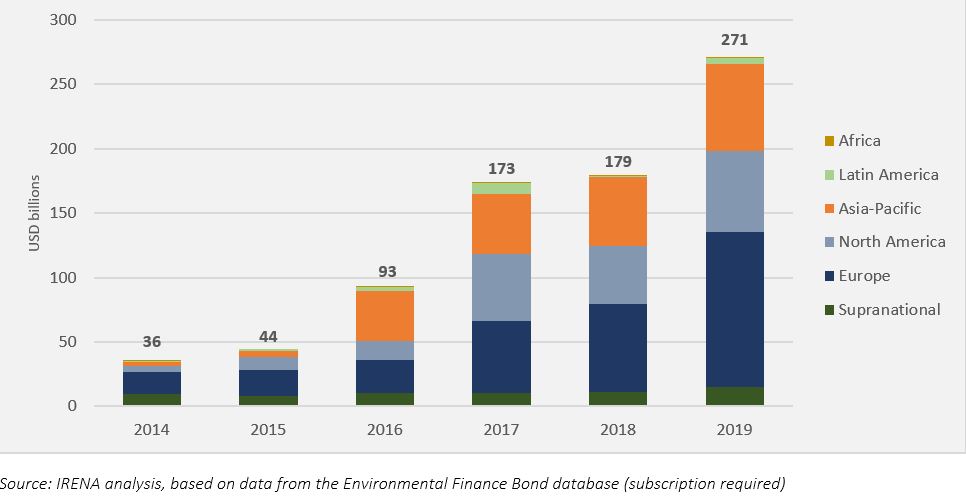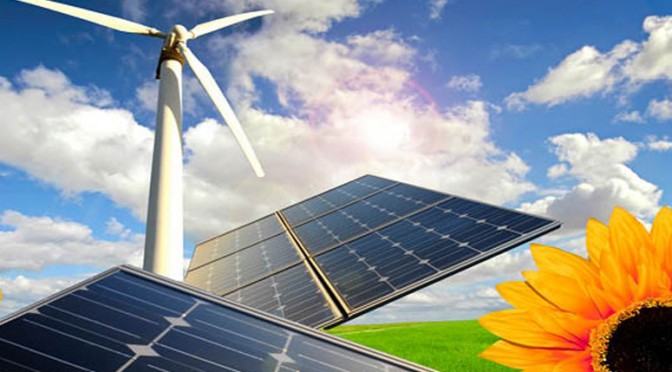Despite the positive renewable energy investment trends over the past decade, annual investments in renewable energy power alone need to double until 2050 to meet climate goals. To allocate enough capital to drive the world’s transition to a low-carbon economy, a set of financial solutions need to be developed and taken advantage of by policymakers, investors and financial institutions. The International Renewable Energy Agency (IRENA) has recently published a series of renewable energy finance briefs looking at tools to scale up renewables. Renewable energy finance: Green bonds highlights green bonds as an innovative instrument that can help channel substantial global capital into renewable energy and other green assets.
By bridging the gap between providers of capital and green assets, green bonds can help governments raise finance for projects to meet climate targets and are enabling investors to achieve sustainability objectives. Like conventional bonds, green bonds allow the bond issuer to raise funds for specific projects or ongoing business. The “green” label tells investors that the funds raised will be used to finance environmentally beneficial projects. IRENA’s brief shows that the volume of green bond issuances has been growing nearly constantly since 2014. The green bond market started a little over a decade ago with the European Investment Bank’s first issuance of a Climate Awareness Bond in 2007, which allocated EUR 600 million to 14 renewable energy and energy efficiency projects. Since then, the green bond market has grown substantially, particularly in the past 5 years, with 2019 issuances reaching a record of USD 270 billion.
Along with the growing amount of capital raised, the market also expanded a growing variety of issuers from different regions – firstly from Europe, then North America, and increasingly from Asia-Pacific and to a smaller extent from Latin America and Africa. Issuers and currencies in which green bonds are offered have also seen diversification. From a market driven primarily by multilateral development banks and development finance institutions, green bonds are now issued by public and private institutions, including governments, government agencies, as well as private corporations and financial institutions.
Annual green bond issuances, per region, 2014-2019, USD billion

Today, renewable energy is present in around half of all green bonds issued. However, green bonds remain well below their potential and too small to drive the global shift to renewables. Even though progress to date has been impressive, the green bond market continues to offer enormous growth potential.
The cumulative issuances of green bonds are below USD 1 trillion, while the global bond market is valued at around USD 100 trillion, accounting for less than 1% of cumulative global bond issuances. To grow the green bond market, co-operation between policy makers, standard setters, capital providers and investors is essential. IRENA’s brief highlights specific coordinated actions that various stakeholders can take to untap the potential of green bonds.
Some of the recommended actions include:
- Policy makers can help increase both the supply of green bonds (through the adoption of leading climate-aligned green bond standards) and the provision of enabling policies that grow the renewable energy sector.
- Public capital providers can do their part to help de-risk renewable assets and can support green bonds through provision of the seed capital, demonstration issuances and capacity building.
- Institutional investors can assist by aligning their internal capacities and investment targets with long-term sustainability mandates.
- Other stakeholders, such as rating agencies, financial institutions and retail investors, also play a role in strengthening the green bond market and advancing the global energy transformation.
For more information, see Renewable energy finance: Green bonds


